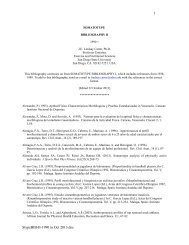THE HEATH-CARTER ANTHROPOMETRIC ... - Somatotype.org
THE HEATH-CARTER ANTHROPOMETRIC ... - Somatotype.org
THE HEATH-CARTER ANTHROPOMETRIC ... - Somatotype.org
You also want an ePaper? Increase the reach of your titles
YUMPU automatically turns print PDFs into web optimized ePapers that Google loves.
<strong>Somatotype</strong> Instruction Manual 16<br />
2. Plotting somatotypes on the 2-D somatochart.<br />
X-coordinate = ectomorphy - endomorphy<br />
Y-coordinate = 2 x mesomorphy - (endomorphy + ectomorphy)<br />
3. <strong>Somatotype</strong> categories.<br />
The following seven categories can be used for simplified classification of samples if the numbers are<br />
large enough. These categories can be used in Chi-square analyses. (Thirteen categories are defined in<br />
Carter, 1980, 1996, and Carter and Heath, 1990.) (See Part 1 for 4 and 13 categories.)<br />
Central: no component differs by more than one unit from the other two.<br />
Endomorph: endomorphy is dominant, mesomorphy and ectomorphy are more than one-half unit<br />
lower.<br />
Endomorph-mesomorph: endomorphy and mesomorphy are equal (or do not differ by more than onehalf<br />
unit), and ectomorphy is smaller.<br />
Mesomorph: mesomorphy is dominant, endomorphy and ectomorphy are more than one-half unit<br />
lower.<br />
Mesomorph-ectomorph: mesomorphy and ectomorphy are equal (or do not differ by more than onehalf<br />
unit), and endomorphy is smaller.<br />
Ectomorph: ectomorphy is dominant, endomorphy and mesomorphy are more than one-half unit lower.<br />
Ectomorph-endomorph: endomorphy and ectomorphy are equal (or do not differ by more than onehalf<br />
unit), and mesomorphy is lower.<br />
4. <strong>Somatotype</strong> attitudinal distance (SAD).<br />
The SAD is the exact difference, in component units between two somatotypes (A, an individual or<br />
group; B, an individual or group), or between two somatotype group means (e.g. A and B), or between<br />
a subject and a group (e.g. subject A and group B).<br />
SAD A;B = [(ENDO A - ENDO B ) 2 + (MESO A - MESO B ) 2 + (ECTO A - ECTO B ) 2 ]<br />
Where: ENDO = endomorphy; MESO = mesomorphy; ECTO = ectomorphy<br />
The somatotype attitudinal mean (SAM) is the mean of a group of somatotypes.<br />
SAM =<br />
SAD i / n X<br />
3/19/2003




